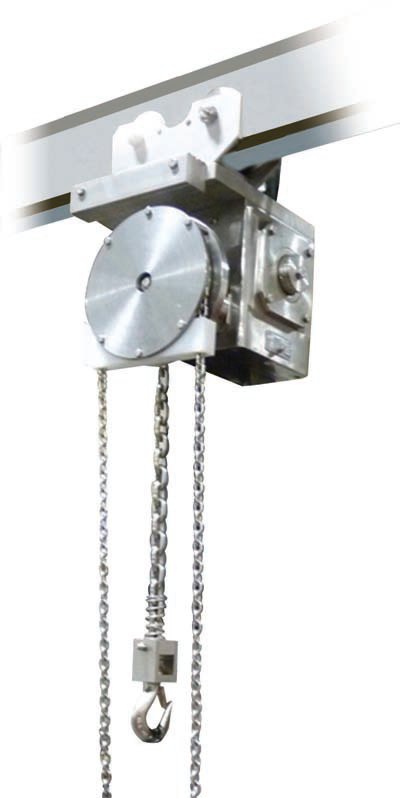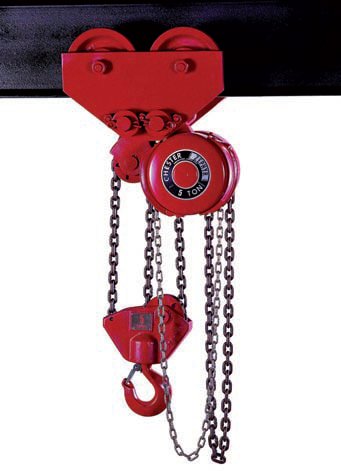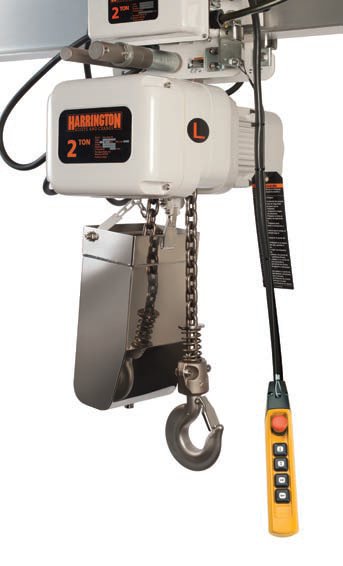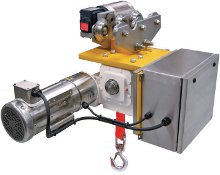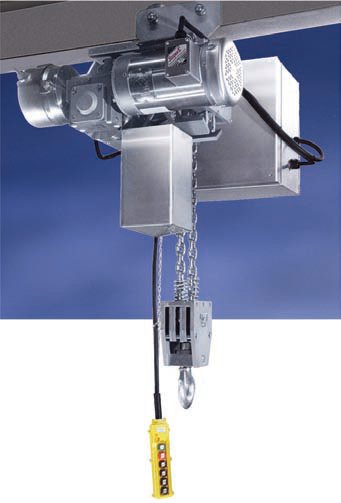A bespoke approach
11 April 2014Defining a food grade hoist and fulfilling customer needs requires a tailored approach, ensuring that there is no one size fits all mentality in this sector, finds Tim Sheahan.
Customers in the food processing, pharmaceutical, and industries require a hoist that will not contaminate their process. Therefore it is integral that suppliers and manufacturers in this space are driving innovation to ensure the end user can benefit from operational and efficiency savings.
"We offer all stainless steel construction for our chain hoists, strap hoists, and wire rope hoists, along with many of our other material handling products being available in all stainless steel construction, says Matt Downing, director of sales and marketing at David Round Company. "It's important to understand the requirements at the end user level by consulting with quality and safety managers and engineers or subcontracted A/E fir ms who can define the requirements for their food grade applications."
Defining the sector
According to Downing, many hoist manufacturers offer what they define as "food grade" by offering options on their standard carbon steel hoists such as the chain being stainless, and hook being stainless, or trolley wheel. "Most all other manufacturers still have paint on their units and the gearing, motors are not stainless steel. In the end, our offering is unique in that our hoists are all stainless steel construction."
Bret Lussow, business development sales manager at Har rington Hoists tackles this from his company' s perspective. "There is no clear cut standard for food grade hoists we offer a range of options because ever y customer has different needs. The starting hoist includes food grade lubricants (oil and grease), epoxy paint, corrosion resistance chain and corrosion resistant hardware throughout," he explains. "The customer then has the option to add various stainless steel components for additional food protection and corrosion resistance such as hooks, trolley wheels, guide rollers, and chain containers. Other options include pendant covers and nickel-plated or nickel diffused suspension and chain."
He adds: "The difference is the menu. We don't pin a customer into buying what Harrington perceives to be their need, we allow them to build a hoist that suits their needs. W e have great inventor y of hoists and components and can virtually build any combination of components in days."
Speciality models
Elsewhere, Columbus McKinnon says it provides a number of specialty models of some of its most popular hoists for food grade applications.
"The CM Lodestar Clean Room Hoist is our electric chain host, featuring stainless steel load chain that guards against flaking or peeling and can withstand high temperatures; a sealed, weather-proof construction that resists rust and corrosion and can be easily cleaned; and uses non-oxidizing grease rather than oil for lubrication to eliminate drips," explains Christie Lagowski, communications specialist at the manufacturer.
"The CM Lodestar Clean Room Hoist also features an FDA-approved white epoxy powder coat paint. We also offers the "Zephyr" Clean Room Hand Chain Hoist that features stainless steel load chain as well as stainless steel upper and lower hooks and hook blocks; FDA-approved, food-grade epoxy paint; food grade lubricants; and a variety of other optional stainless steel or electroless nickel plated components suitable for food-grade environments," she says.
According to Lagowski, the firm also offers trolleys for these types of environments in the for m of its 'Ultimate Clean Room Trolley' that is pitched for humid environments and washdown areas. "The trolley is constructed entirely of corrosion-resistant stainless steel and features stainless steel precision ball bearings that are sealed and lubricated for life. This trolley is rated for up to 225 degree F ambient temperatures," she explains.
Blanket approach
There can be no blanket approach to fulfilling the requirements of end users in the food and cleanroom sectors. However, this is as much an opportunity as it is a challenge for the companies in this space.
"Because Washington DC unfortunately remains gridlocked in other legislation, the FDA still has regulations under evaluation, so the decisions for cleanliness and safety remain in the hands of each end user/ customer," explains Downing.
"Their quality and safety managers and engineers or subcontracted A/E firms typically either write specifications outlining the requirements for materials of constructions and/or surface finish requirements for the hoist," he says.
"As a general rule, if the hoist is handling the product, or mounted directly above the product, then all stainless steel construction is typically required. If the hoist is operating in a maintenance area not handling the product, then the other "food grade" options on the market that are painted come into play."
Another issue, according to Downing, is the sufficient education of companies as to the benefits of these products. "Educating them on the price differences between all stainless steel construction versus other hoists on the market that call their units "food grade" but almost always have painted, carbon steel construction in their designs," he says.
Clear-cut
This is a point echoed by Har rington Hoists' Bret Lussow, who says there is no clear-cut food grade standard for hoists. "The biggest challenge is maintaining strength and integrity with stainless components in lifting applications," he says. "We find customers are either completely shocked by the expense of stainless or so accustomed to paying high prices for stainless components that they don't hesitate to spend the money. When a customer knows what they want, price is generally not an issue; lead-time becomes the bigger issue."
For Columbus McKinnon, there is no specific legislation that it designs its hoists to meet with all customers are looking for the most economic hoist that can meet their needs.
"Though these hoists have special features, they still need them at a price that fits into their budget. Besides contamination, process interruption can have a significant effect on product output, in that, entire batches of product may be destroyed if production is disrupted," says Lagowski. "Rather than simply purchasing the lowest priced unit, customers are now taking into consideration the total cost ownership of the hoist. High uptime and reliability along with low maintenance time and costs are important decision factors."
Finding a hoist that can handle heavy-duty applications, but is also suitable for use in environments with high humidity and corrosive materials is a key challenge, according to Columbus McKinnon. "Hoists used in food-grade environments have to be suitable for sanitary conditions, which can be difficult as most hoists are made of metal and use grease or other lubrication that can drip from the hoist and contaminate food products. Also, these specialized hoists can be expensive, so finding an affordable option is often a challenge," she adds.
Cleanrooms and material handling
Cleanrooms are big business for manufacturers in the world of material handling. Here, Sean Fryers from manufacturer and supplier Connect 2 Cleanrooms places the spotlight on modular cleanrooms and their importance in the manufacturing sector.
Potentially harmful particles exist in everyday medical plastics manufacturing environments and can cause potential failure to product production, which is susceptible to contamination or every day micro- organisms.
Modular cleanroom constructions are typically built as freestanding, solid and robust structure suitable for use for injection moulding, extrusion and thermoforming processes.
A modular cleanroom will use standard off the shelf proprietary components that when combined with the customer's requirements; for example size, ISO classification, lighting, hard or soft wall will create a 100% bespoke room thus reducing cost and lead time.
The use of 99.99% efficient HEPA/ ULPA filtration is generally used to reach the required cleanroom classification. This creates an exceptionally clean environment with 0.3 and 0.1 micron filtration respectively. Variable speed adjustments means that air changes in the room can be changed as necessary whilst maintaining quality but reducing cost in off peak times.
Cleanroom ISO Classification
A cleanroom can be designed to achieve various ISO 14644-1 Classifications of air cleanliness. The very nature of the process often dictates the ISO Classification required, for example certain medical products implanted within a human body or certain food packing processes would need to be manufactured in a cleanroom with a higher classification than a company that is producing plastic lids.
However, if the plastic lids were to come in contact with food, the ISO Classification would need to be higher. The main rule of thumb is to consider your process, determine the quality that you need to achieve using industry regulatory guidelines and if in doubt, speak to a reputable cleanroom company to gain professional advice.
Increasing demand
The demand for modular cleanrooms is on the increase as more processes are benefiting from a cleanroom environment. With this demand comes a cost and companies are obviously going to look for the best solution to fit their needs and budget.
Due to recent years of cut backs that many industries have witnessed, small, medium and large organisations have had to re think their company strategies and become leaner in the way they manage processes. Modular cleanrooms are part of that leaner way of thinking, as contract manufacturers are finding they can dramatically increase their scope of work by introducing cleanroom facilities.
With traditional build cleanrooms, retrospective modifications are often a lengthy and costly process, so future demands must be accounted for in the initial specification. Modular solutions are more flexible as expansions and relocations can be accommodated much more easily. In these uncertain times companies are seeing the fact that they can stagger their investment to grow with contract wins or developments as a real benefit.
Dramatic design improvements have also led to an increased demand for modular cleanrooms. The use of clear solid wall panels has led to an improved perception of the modular design of cleanrooms. They are no longer seen as the temporary, low budget option and now offer a reliable and robust alternative to the traditional build cleanrooms.
Bespoke Design
Various cleanroom solutions can be offered to fit the many different processes offered within the medical plastics sector. The modular design creates a localized clean area which offers a solution that can be tailored to suit each organizations specific machinery.
A fixed ballroom design with no internal supports, where cleanrooms can be designed to house large machinery with access panels located in the ceiling, which can be removed to allow a crane travelling above the cleanroom access to the machinery in the cleanroom.
Localized or part coverage of a machine by a cleanroom is often used when a specific area of the process needs to achieve a cleanroom standard. This can be, for example, at the packing end of a machine where the product would have to be transferred and packed in an environment where particle reduction would be imperative.
Whole coverage of a machine by a cleanroom is also a common prospect, which can unearth interesting variables such as height of a robotic ar m housed on top of an injection moulding machine. The advantage of a modular cleanrooms is that it can be deigned in such a bespoke manner that all variables are more often than not catered for.
High performance cleanroom solutions can be designed to be integral to the machine in the form of air-conditioned laminar flow hoods that can feed cool, particulate free air onto the machines. The airflow over the injection moulding tool can kept at a predetermined cool temperature to ensure that condensation does not harm the processes.
